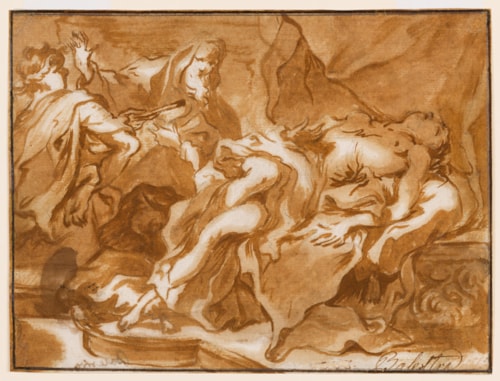
Giovanni Battista PITTONI
Venice 1687 - Venice 1767
Biography
Among the foremost history painters in 18th century Venice, Giambattista Pittoni worked for his entire career in the city on the lagoon. He was a pupil of his uncle, the minor painter Francesco Pittoni, and is first recorded in the archives of the Venetian painter’s guild, the Fraglia dei Pittori, in 1716. Four years later he painted a Martyrdom of Saint Thomas for the church of San Stae in Venice, and at around the same time may have travelled to Paris, in the company of his uncle Francesco and fellow artists Rosalba Carriera and Giovanni Antonio Pellegrini, as well as the engraver, critic and connoisseur Count Anton Maria Zanetti. As Alessandro Bettagno has noted of the artist, ‘By the beginning of the 1720s his style was fully developed…Pittoni emerges as a bold colourist, capable of organising highly complex, sensitive and elegant compositions.’
Between 1715 and the early 1720s Pittoni painted, alongside his ecclesiastical commissions, a series of mythological pictures that seem to reflect a knowledge of French art of the period. As another scholar has written, ‘In the 1720s and 30s he produced with a nervous brush light and vibrant rococo pictures, which reveal his attachment to Sebastiano Ricci and Tiepolo. A sophisticated colourist, he shows in his works a fragrant elegance and an arcadian mood distinctly close in feeling to the French Rococo.’ In the late 1720s Pittoni painted a series of decorative frescoes for the Palazzetto Widmann at Bagnoli di Sopra, and he continued to work for private patrons in and around Venice for much of his career. He painted altarpieces for churches in Venice, Vicenza, Milan and Brescia, and around 1730 worked on an altarpiece for a chapel in the church of the Maddalena in Parma, which also contained paintings commissioned from Giambattista Piazzetta and Giambattista Tiepolo, the other two great history painters of the era. Five years later Pittoni painted an altarpiece of The Martyrdom of Saint Bartholomew for the basilica of San Antonio in Padua, where it was again placed alongside works by Tiepolo and Piazzetta, as well as Giovanni Antonio Pellegrini. In 1740 he painted a series of frescoes in the Ca’ Pesaro in Venice, and among his late works are paintings for the Venetian churches of San Cassiano and San Giacomo dell’Orio, where the artist was eventually buried.
Pittoni’s cabinet paintings of religious, historical and mythological subjects found a ready audience among collectors not only in Italy but also further afield, in Germany, Poland and Russia. (The artist himself seems rarely to have left Venice, however, apart from a possible brief trip to France early in his career, and in fact he may have been among the least travelled of the major Venetian painters of the 18th century.) One of Pittoni’s significant patrons was the distinguished German soldier and art collector resident in Venice, Johann Matthias von der Schulenberg, while the artist counted among his pupils and assistants such foreign painters as Anton Kern and Franz Unterberger, ensuring that his work was influential and popular throughout Central Europe. Pittoni was a founding member of the Accademia Veneziana and succeeded Tiepolo as the second principe of the institution, serving between 1758 and 1762. In his Della pittura veneziana e delle opere pubbliche de’veneziani maestri, published in 1771, a few years after the artist’s death, the Venetian art historian Anton Maria Zanetti the Younger recalled of Pittoni that ‘He was the master of an original style, full of picturesque traits, graceful and pleasing…His paintings were adorned with much charm and an abundance of beautiful images.’
As a draughtsman, Pittoni was influenced by Sebastiano Ricci and Pellegrini, while his supposed trip to France around 1720 may explain the strong French characteristics in his mature drawings. Some three hundred of his drawings survive, almost all of which are today in the collections of the Fondazione Giorgio Cini and the Galleria dell’Accademia in Venice; these represent the remains of the contents of the artist’s studio, acquired by Baron Ugo Salvotti. Only a handful of drawings by Pittoni are now to be found outside Venice, however, and very few are in museum collections in Europe or America.


